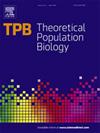费勒扩散以一个单一的祖先奠基人为条件。
IF 1.3
4区 生物学
Q4 ECOLOGY
引用次数: 0
摘要
我们研究了Feller扩散(X(τ))τ∈[0,t]的分布特性,条件是当前种群X(t)在时间0时具有单一祖先。该方法是新颖的,基于Feller原始解决方案的解释,根据该解决方案,当前种群由指数分布的家族的泊松数组成,每个家族都来自单个祖先。中间时间的祖先数量分布和接合时间的联合密度是在以下假设下确定的:在过去的特定时间,包括无限远的过去,从一个单一的祖先开始这个过程,以及在开始后的时间有一个均匀的先验。还计算了当前种群从最近的共同祖先开始的时间的联合分布,以及当时在不同假设下的同期种群规模。在每种情况下,都给出了超临界、临界和亚临界扩散的精确解。对于超临界扩散,给出了无界指数增长极限下分布的渐近形式。本文章由计算机程序翻译,如有差异,请以英文原文为准。
The Feller diffusion conditioned on a single ancestral founder
We examine the distributional properties of a Feller diffusion conditioned on the current population having a single ancestor at time zero. The approach is novel and is based on an interpretation of Feller’s original solution according to which the current population is comprised of a Poisson number of exponentially distributed families, each descended from a single ancestor. The distribution of the number of ancestors at intermediate times and the joint density of coalescent times is determined under assumptions of initiation of the process from a single ancestor at a specified time in the past, including infinitely far in the past, and for the case of a uniform prior on the time since initiation. Also calculated are the joint distribution of the time since the most recent common ancestor of the current population and the contemporaneous population size at that time under different assumptions on the time since initiation. In each case exact solutions are given for supercritical, critical and subcritical diffusions. For supercritical diffusions asymptotic forms of distributions are also given in the limit of unbounded exponential growth.
求助全文
通过发布文献求助,成功后即可免费获取论文全文。
去求助
来源期刊

Theoretical Population Biology
生物-进化生物学
CiteScore
2.50
自引率
14.30%
发文量
43
审稿时长
6-12 weeks
期刊介绍:
An interdisciplinary journal, Theoretical Population Biology presents articles on theoretical aspects of the biology of populations, particularly in the areas of demography, ecology, epidemiology, evolution, and genetics. Emphasis is on the development of mathematical theory and models that enhance the understanding of biological phenomena.
Articles highlight the motivation and significance of the work for advancing progress in biology, relying on a substantial mathematical effort to obtain biological insight. The journal also presents empirical results and computational and statistical methods directly impinging on theoretical problems in population biology.
 求助内容:
求助内容: 应助结果提醒方式:
应助结果提醒方式:


